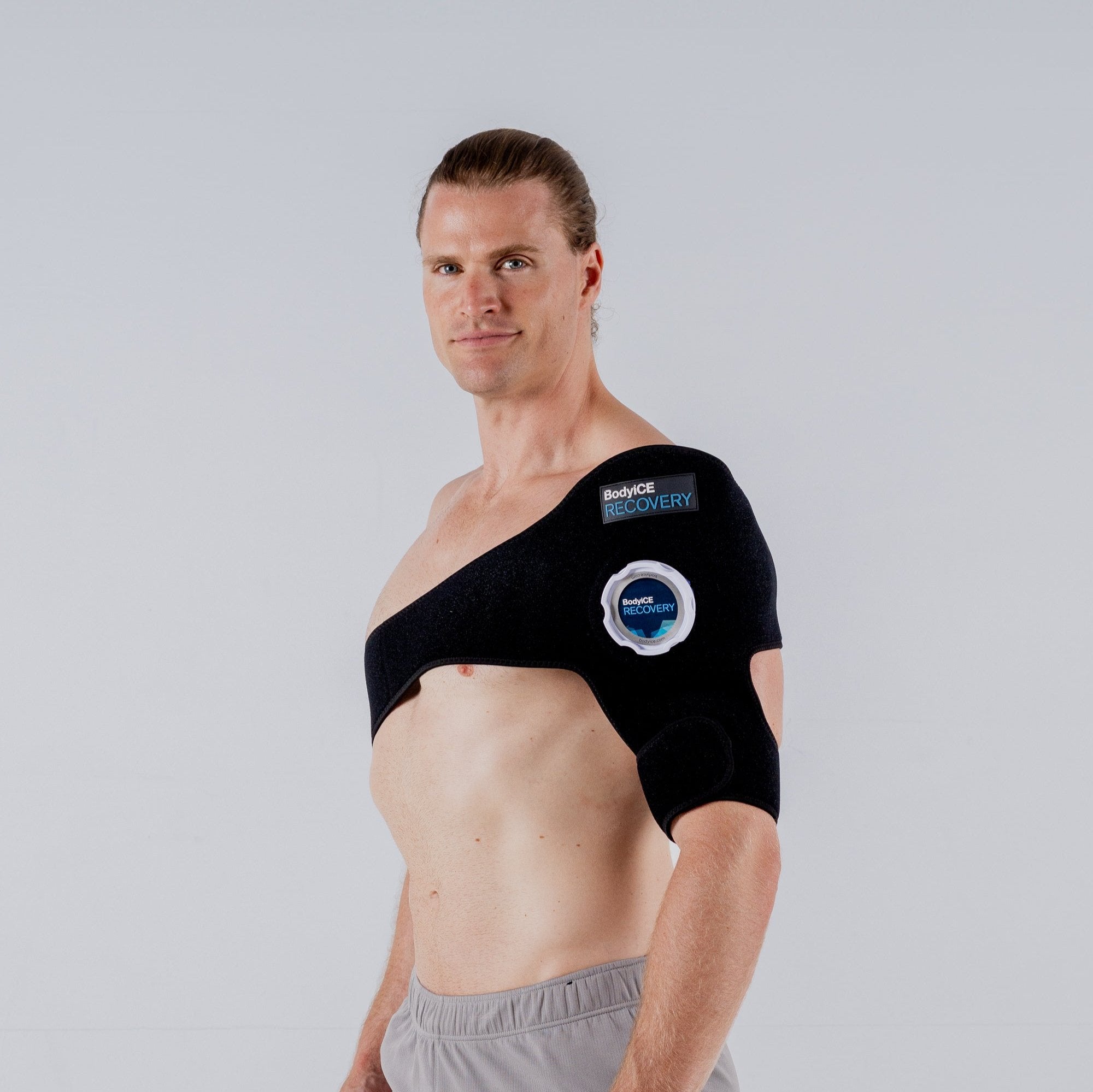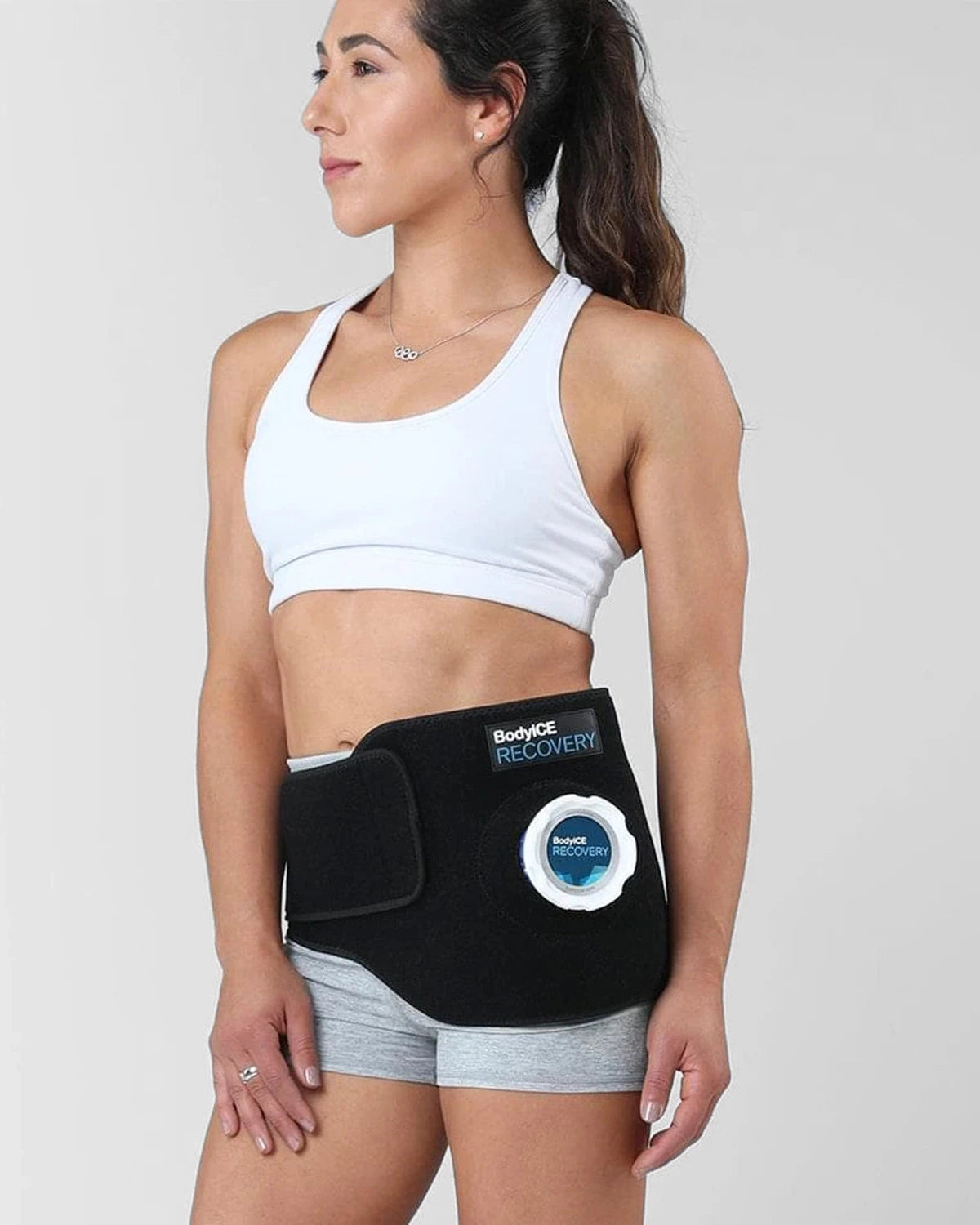HOW IT ALL STARTED - A PAINFUL CHAPTER
It's hard to believe, but it's been 16 years since I founded BodyICE so if you're wondering how it all started, let me take you back to the beginning… back to a painful chapter in my life.
It's 2005. I was a young ambitious aerial skier, fearless and determined to leave my mark on the sport and every competitor in my wake. Whilst I was enjoying success on the World Cup stage, I was frequently injured. A shoulder reconstruction, slipped discs and stress fractures in my back, cysts on my ankle and concussions. In aerial skiing, you have to be willing to take risks if you want the ultimate rewards and I was going for it.

To help manage my injuries, I found great relief from cold therapy. It helped with pain relief but also swelling and inflammation. However, the products I was using (which at that time were out of the USA), had significant design flaws.
A lot of the products coupled a traditional ice bag with a neoprene wrap which was great, but often the ice bags leaked and the opening was too small to quickly get ice into. To keep the ice bag in place, there were often neoprene straps – however, the straps were of poor quality, the Velcro lost its stick and they weren't really specific to any joint of the area.
There were less than a handful of products on the market in Australia and most of them were gel packs (which were not affective in retaining their temperature) or ice bags with a universal neoprene wrap (rather than a specific knee wrap) that didn't secure properly. What I needed was cryotherapy with compression.
PAIN & FRUSTRATION = MOTIVATION

Leading into the 2006 Winter Olympics, I knew I had a shot of being an Olympic champion. About 6 months before, I had a freakish accident whereby my knee twisted 180 degrees whilst skiing up a jump.
At that moment, I ruptured my Anterior Cruciate Ligament (ACL) in my knee for the first time. My world at that time, came crashing down. This knee injury was major, it was bad timing and my plans were abruptly going to change.
My knee was too unstable to continue, so I ended up having a radical surgery using a ‘donor' tendon. This meant that my surgeon wouldn't use my own hamstring or patella tendon, but in this case, part of an Achilles tendon from an organ donor. It's called an allograft.
After knee surgery, I was constantly icing. Let's just say, I went through a lot of ice packs. I was doing 3 rehab sessions per day and I was racing against the clock to make it to the Olympics.
I did the work and made it back to peak performance. An ice pack to me, was my security blanket. It felt good, it kept the heat and inflammation down in my knee and my rehab was on track. I made it back in time for the Olympics and was in fine form.
What I didn't know at the time was that grafts go through phases of strengthening and weakening. Everything was going well. Even with the heavy load of aerial skiing, I was managing my knee – mainly with ice and physio treatment.
WHEN THINGS GO FROM BAD TO WORSE
And then, I flew over to Italy, to where the 2006 Winter Olympics were held. I remember getting off the plane feeling pretty stiff and sore from the long travel day and in the subsequent days, my knee was getting angrier and angrier despite icing, anti-inflammatory medicines and physiotherapy. I was in constant pain and even bowed out of walking in the opening ceremony to save myself from being out in the cold and on my feet for too long.
What I didn't realise was that my graft was going through a phase of weakening. My knee wasn't happy. It was so swollen, I had lost my range of motion and it was actually catching and locking up on me.
As if competing at the Olympics isn't stressful enough? Despite this, I was jumping really well and you couldn't tell how uncomfortable I was, how much in pain I was, nor how scared I was.
In the semi-final we had two qualifying jumps to make it to the final of 12. After my first jump, which was as near perfect as I could have done, I was comfortably in 2nd place. As the night progressed and I waited my turn for my next jump, I could feel my knee get stiffer and stiffer.
It just had to hold on for one more jump and then I'd have a day off to rest before the finals. On my second jump, and as soon as my skis came in contact with the landing hill, I felt that familiar snap as my knee gave out.
My ACL snapped, and my dream of being an Olympic champion was over in an instant. It was the lowest point in my career and I was broken not just physically but mentally and emotionally as well.

WHEN PAIN LEADS TO INSPIRATION
I remember sitting in the dining hall of the Olympic Village surrounded by my fellow Aussies teammates. My spirits were low and I had my knee elevated resting on a chair balancing a shopping bag of ice. There was a puddle of water under me and it kept sliding off my knee. In frustration, I picked it up and threw it on the ground and spat out the words ‘Someone needs to make a decent fu**ing ice pack that doesn't leak or slip!' Everyone just stared at me and said, ‘well, why don't you do it?'. Cue lightbulb moment.
On my flight home, I couldn't sleep. The nightmare of what happened was on repeat. So I got out my journal and started sketching the first concepts of what would become BodyICE.
THE BODYICE FEATURES
By that stage, I had a very good idea of what I was needing and what didn't exist at the time. The ice packs had to meet these criteria:
- They needed to be able to strap on to specific joints and areas. Most straps at that time were universal – meaning you were to try and use them on different parts of your body but the fact was, it didn't work. If you needed to ice your shoulder, you needed a shoulder ice pack, a knee ice pack for a knee and so on.
- They needed to be durable and not fall apart after a few uses. They had to be premium.
- They needed to be able to be used as a heat pack – some of my injuries (like my back) respond better to heat.
- They needed to stay cold and stay in place.
- They needed to be portable, easy and light to travel with.
- They need to offer comfortable level of compression.
AN ACCIDENTAL BUSINESS
Once I got home, I hit the ground limping. I had to have another ACL reconstruction - this time using my own hamstring tendon. I decided to give myself a whole year to avoid rushing the healing process and rehabilitation back to full fitness. I never wanted to experience that kind of disappointment again.
I threw myself into my rehab and at the same time started developing BodyICE – I didn't realise it at the time, but throwing my energy into another project helped me get through that difficult period. I had to slowly build back my knee and my confidence and having something else to ‘work' on kept me away from frequent pity parties. I decided I would couple the traditional ice bag with a joint specific neoprene support as I felt that was still the simplest and most effective way to ice an injury. Once I drew my designs, I went to a local fabric store to find some neoprene and I made some very basic prototypes. I had an ice bag but I needed to find a supplier that would make a larger opening in the lid so that I could get ice into the bag quicker.
I started researching potential manufacturers in Australia. I holidayed frequently down on the surf coast of Victoria – where all the surf brands were born and I asked them if they knew anyone who could help me make my products.
At that time, all manufacturing had moved offshore so offshore I went as well. Within weeks, I found myself in China – at trade fairs and meeting with manufacturers. From there I made a shortlist of potential manufacturers and proceeded with samples. I chose the best ones for quality and made my first order. Within 6 months of lying in the snow clutching at my knee in devastation, I had a business up and running. BodyICE was born.

HELPING PEOPLE RECOVER BETTER
Since 2007, we have supplied hundreds of thousands of ice packs to help people recover from acute injury as well as chronic injury. From athletes, weekend warriors, to the elders we have provided relief to those having knee and hip replacement surgery, shoulder reconstruction, ACL reconstruction and of course any other orthopaedic surgery or sports injury.
Personally, BodyICE and cold therapy in general, significantly helped me manage my injuries and since that frightful night in Torino, I went on to win Olympic Gold in Vancouver 2010, Bronze at the 2014 Olympics and continued to represent Australia right up to my final Winter Olympics appearance in 2018.
I often say blowing my ACL twice in the space of 6 months was the best thing that could have happened to me. It made me mentally resilient and gave me the opportunity to create a business. Through my adversity and set back, BodyICE was borne.

PEOPLE FIRST, BUSINESS SECOND
It brings me so much pride and comfort to know we've helped so many people through what can be very intense pain and a long road to recovery.
BodyICE didn't start out of a desire to create a business. It started out of frustration and from a place of pain and agony. I wanted to recover from my injury and I figured a lot of other people were dealing with the same trauma.
I wanted people to use simple cold therapy and not rely on pain killers and other pharmaceuticals.
Over the years, I've seen a lot of competitor products pop up on the market. Some – no doubt, have evolved through great ‘inspiration' from my BodyICE Recovery range. Some have gone as quickly as they came. Some a great options, but very bulky and expensive.
WHAT ARE YOUR OPTIONS TODAY FOR INJURY ICE PACKS?
- Gel Packs
- Icing Units
- Frozen Peas
GEL PACKS
Let's talk about sports gel packs or even phase change material packs. Let's face it, I've met many and have never met one I've liked. Basically, they're too cold and stiff to begin with and then rapidly lose their temperature. They often don't include comfortable compression.
Can you take a gel pack on a plane? It's risky – even if you managed to get it through security, how will you keep it cold? Will it stay in place? No… not comfortably. Can you move around? Again no, I've tried.
But with BodyICE, you can take it anywhere. Long bus rides, long haul flights, train travel, cars, hotel lobbies, you name it. You can always re-fill with ice and I can't tell you how many times I've asked for a large cup of ice from a fast food chain or from a flight attendant. Not to this day have I been rejected.
ICING UNITS
Then there are the icing units. I like these and they work, but they're expensive and they're bulky to travel with. Honestly, you may as well get in an ice bath which is brilliant for injury recovery or a whole-body flush.
FROZEN PEAS
If you're using frozen peas then you're not being serious about your recovery. It's just not going to cut it so why bother? If you're using a shopping bag of ice with plastic wrap, then you're in for a messy, wet clean up – not to mention contributing to an irresponsible use of plastic [cringe].
BODYICE: SIMPLE, AFFORDABLE ICE AND COMPRESSION

After a ski or a long run, I just want to put my feet up and pop my knee on ice with my trusted and tested knee ice pack. I want to feel that instant relief and cold compression around my joint. I want to be able to get up and walk around if I have to. I want to be able to ice on a plane, train, in a car or wherever my life takes me.
Great products are often borne out of necessity and it couldn't be more true for BodyICE. It brings me great satisfaction to know we've helped so many people with pain relief and managing their injuries.
Our BodyICE Recovery range is trusted and prescribed by orthopaedic surgeons and medical professionals nation-wide. Stay tuned for part 2 and discover the inspiration behind BodyICE Woman and Kids.













Leave a comment
All comments are moderated before being published.
This site is protected by hCaptcha and the hCaptcha Privacy Policy and Terms of Service apply.